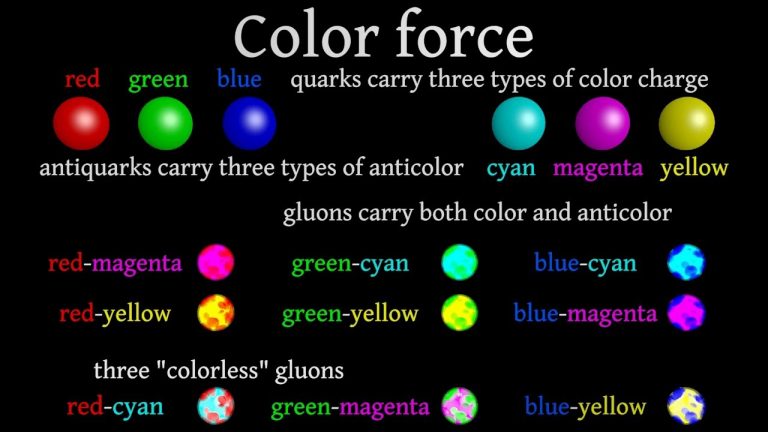Gluons, the enigmatic particles that facilitate the interplay within the nucleus of an atom, are often deemed the whimsical glue binding quarks together in the realm of quantum chromodynamics (QCD). These force carriers, analogous to the invisible threads weaving a tapestry, maintain the integrity of atomic structures while simultaneously participating in the continuous dance of energy and matter at the subatomic level. The world of gluons extends far beyond mere binding; they embody the complexities and peculiarities that characterize our understanding of the universe.
To appreciate gluons fully, one must traverse the landscape of particle physics, meandering through fundamental concepts such as quarks and forces. At the heart of this exploration lies the strong interaction, the most potent of the four fundamental forces, which governs the behavior of quarks, the constitutive elements of protons and neutrons. Gluons are the mediators of this force, analogous to messengers transmitting interactions and ensuring stability across the confines of atomic nuclei.
The relationship between quarks and gluons is intricately woven, reminiscent of a myriad of dancers moving in unison within a grand performance. Quarks, which exist in three flavors — up, down, and strange — are never found freely in nature. Instead, they are perpetually ensconced within hadrons, held tightly by the relentless pull of gluons. These gluons, in contrast, possess no mass but exhibit an astonishingly high energy profile, creating a force strong enough to transcend the mere attractions of electromagnetic forces.
As we delve deeper into the characteristics of gluons, one uncovers their remarkable duality. While they are the carriers of the strong force, they also engage in self-interaction, something unique to this class of particles. One can envision gluons as both poets and protagonists within the narrative of subatomic existence — they compose the fabric of interactions while also being woven into it. Such a characteristic is pivotal in understanding phenomena such as confinement, wherein quarks and gluons remain perpetually bound and elusive, never allowing isolation.
The canvas of gluons extends further into the realm of theoretical and astrophysical implications. When considering the implications of gluons in the cosmos, one begins to comprehend how these particles might play a role in cosmic phenomena and the evolution of the universe itself. Theoretical frameworks suggest that gluons may contribute to the processes that govern the early universe, engendering conditions suitable for the formation of matter as we know it. In this respect, gluons are not merely confined to the particle accelerator domains of Earth; they are also cosmic players, resonating through space-time and influencing the very fabric of creation.
Gluons introduce a beguiling complexity to the concept of color charge, a property that distinguishes them from other force carriers such as photons. Color charge is not related to visual perception but signifies the strong force dynamics at play. Just as an artist uses a palette of colors to evoke emotion, gluons embody color charges that dictate their interactions. This intricate interplay leads to a phenomenon known as asymptotic freedom, where particles interact more weakly at short distances. Conversely, at larger distances, their coupling strengthens dramatically, manifesting confinement. Here, the metaphorical tapestry thickens, as the otherwise invisible forces become palpable, guiding the interactions and behaviors of fundamental particles.
In a broader cosmic narrative, the role of gluons has implications that transcend traditional atomic physics. They may help illuminate dark matter and dark energy, the elusive constituents of our universe that elude understanding yet dictate large-scale structure and evolution. With their propensity for complex interactions and the ability to affect particles at considerable distances, gluons may hold keys to unlocking mysteries surrounding the beginnings of cosmic inflation, shedding light on the uniformity observed in the Cosmic Microwave Background (CMB).
Furthermore, the study of gluons may help inform advanced technologies, including quantum computing and high-energy particle accelerators. As researchers probe deeper into the underpinnings of gluonic interactions, potential applications may arise, enabling innovations that harness the principles of quantum mechanics for technological advancement. The metaphor here extends to an architect designing a structure: a deeper understanding of gluons can enable the construction of more complex models, scaffolding a future replete with possibilities.
In conclusion, gluons represent more than mere particles within the physics lexicon; they are harbingers of intricate interactions governing matter and energy, players in the cosmic drama unfolding across the vast expanses of the universe. Through the lens of quantum chromodynamics, one observes not just the binding force of nature but also a poetic complexity uniting the smallest dimensions of reality with the grand tapestry of the cosmos. As scientific inquiry progresses, the exploration of gluons will undoubtedly continue to inspire awe and fuel deeper questions about existence, the universe, and the forces that govern it, beckoning us toward the horizons of theoretical and observational cosmology.












